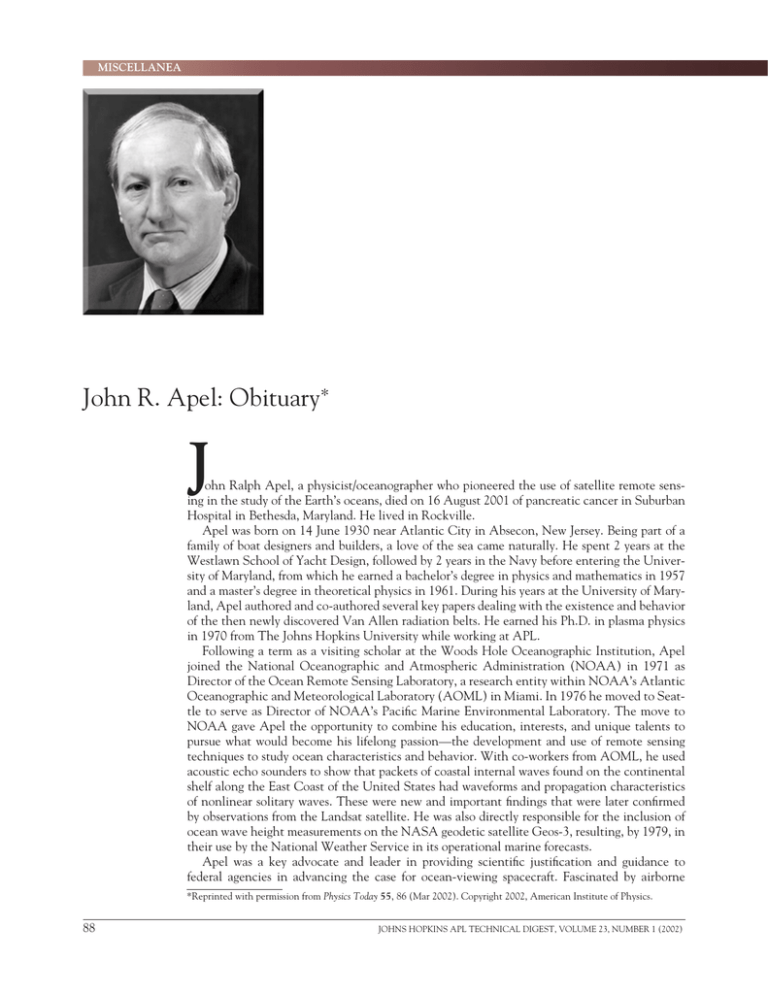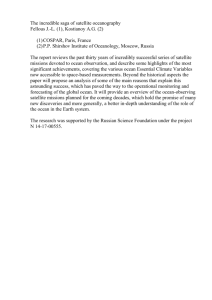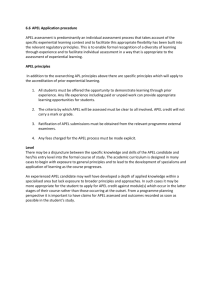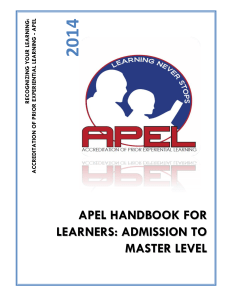J John R. Apel: Obituary *
advertisement

D. J. WILLIAMS AND R. F. GASPAROVIC � ����������� John R. Apel: Obituary* J ohn Ralph Apel, a physicist/oceanographer who pioneered the use of satellite remote sensing in the study of the Earth’s oceans, died on 16 August 2001 of pancreatic cancer in Suburban Hospital in Bethesda, Maryland. He lived in Rockville. Apel was born on 14 June 1930 near Atlantic City in Absecon, New Jersey. Being part of a family of boat designers and builders, a love of the sea came naturally. He spent 2 years at the Westlawn School of Yacht Design, followed by 2 years in the Navy before entering the University of Maryland, from which he earned a bachelor’s degree in physics and mathematics in 1957 and a master’s degree in theoretical physics in 1961. During his years at the University of Maryland, Apel authored and co-authored several key papers dealing with the existence and behavior of the then newly discovered Van Allen radiation belts. He earned his Ph.D. in plasma physics in 1970 from The Johns Hopkins University while working at APL. Following a term as a visiting scholar at the Woods Hole Oceanographic Institution, Apel joined the National Oceanographic and Atmospheric Administration (NOAA) in 1971 as Director of the Ocean Remote Sensing Laboratory, a research entity within NOAA’s Atlantic Oceanographic and Meteorological Laboratory (AOML) in Miami. In 1976 he moved to Seattle to serve as Director of NOAA’s Pacific Marine Environmental Laboratory. The move to NOAA gave Apel the opportunity to combine his education, interests, and unique talents to pursue what would become his lifelong passion—the development and use of remote sensing techniques to study ocean characteristics and behavior. With co-workers from AOML, he used acoustic echo sounders to show that packets of coastal internal waves found on the continental shelf along the East Coast of the United States had waveforms and propagation characteristics of nonlinear solitary waves. These were new and important findings that were later confirmed by observations from the Landsat satellite. He was also directly responsible for the inclusion of ocean wave height measurements on the NASA geodetic satellite Geos-3, resulting, by 1979, in their use by the National Weather Service in its operational marine forecasts. Apel was a key advocate and leader in providing scientific justification and guidance to federal agencies in advancing the case for ocean-viewing spacecraft. Fascinated by airborne *Reprinted with permission from Physics Today 55, 86 (Mar 2002). Copyright 2002, American Institute of Physics. 88 JOHNS HOPKINS APL TECHNICAL DIGEST, VOLUME 23, NUMBER 1 (2002) JOHN R. APEL: OBITUARY radar images of ocean wave patterns and internal wave packets along the West Coast of the United States, he became one of the principal advocates for including synthetic aperture radar on NASA’s Seasat satellite, launched in 1978. While on assignment to NASA in 1973–1975 Apel provided scientific leadership and mission design concepts for the Seasat mission, a highly successful, forward-looking endeavor that paved the way for following generations of ocean-viewing satellites, providing improved measuring and monitoring of the world’s oceans. Continuing his studies of internal ocean waves, Apel led a major oceanic expedition in 1980 on the NOAA research ship Oceanographer to study large-amplitude internal waves in the Sulu Sea. This expertly designed and skillfully executed experiment yielded comprehensive and unprecedented data for testing theories of the generation, propagation, and dissipation of deep ocean, nonlinear internal waves. Apel returned to APL in 1982 where, along with his new duties as a Laboratory Assistant Director, he continued his research on remote sensing of internal waves. Always eager to go to sea, he participated in numerous field experiments with collaborators at the Laboratory and at institutions in Norway, the United Kingdom, and the Institute for Space Research in Moscow. He retired from the Laboratory in 1996 as the Chief Scientist of the Research Center and formed Global Ocean JOHNS HOPKINS APL TECHNICAL DIGEST, VOLUME 23, NUMBER 1 (2002) Associates, a research and development company in Rockville, Maryland. A prolific author, Apel wrote the highly successful textbook Principles of Ocean Physics (Academic Press, 1987), now in its fourth printing. He was elected a foreign member of the Norwegian Academy of Technical Sciences and was awarded the NASA/Department of Interior William T. Pecora Award in recognition of his visionary and pioneering contributions in the field of satellite oceanography. Throughout his career Apel advocated and practiced the use of basic physics principles in the study of the world’s oceans. His excellent grounding in physics, coupled with his love of the sea, provided him with a unique opportunity to successfully pursue his goal. Apel also was a gifted sculptor, a talented gardener, and an excellent and enthusiastic boatsman. His seamanship and navigation skills with a sextant were amazing to behold. Drawing from the knowledge and experience of his earlier years, Apel designed and built (in his basement) a classic all-mahogany Sweet 16 runabout that he, his family, and his friends enjoyed for many years. Those who knew and worked with him found him to be a dedicated researcher, a visionary leader, and a delightful companion. He leaves a void that will be difficult to fill. Donald J. Williams Richard F. Gasparovic 89




